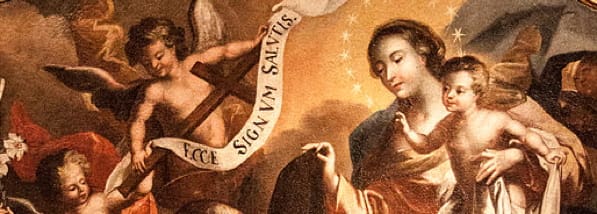What is the scapular, and why is it so important to Carmelites?
Do you remember what Our Lady was wearing when she appeared to Bernadette? How about her appearance as Our Lady of La Salette? How did Juan Diego describe her or how did she appear on his tilma? It seems Our Lady had a different wardrobe each time!
Whenever a visionary describes the appearance of Our Lady when she makes herself visible to the seer, it usually includes a description of what she was wearing. Often her clothing is symbolic and is related to the message she wishes to impart.
The clothing of the people of any culture, historical period, or even of different eras here in our own country tells us much about the people of that age and mothers of all times have spent a good part of their daily activities providing and maintaining clothing for their families. These garments provide warmth, protection, dignity for our personhood, as well as identification of our culture or historical period.
Perhaps you yourselves have memories or stories of your mother making special sacrifices to provide you with new clothing for a special occasion, taking you shopping for new outfits, buying material to make garments, or perhaps even disagreements as to what you should wear on any given day or occasion. Whatever we may recall, it is a mother’s love that is evoked as she struggles to supply both our needs and not offend our tastes.
Mary is no less concerned than our earthly mothers but her care lies primarily in the spiritual realm; thus she clothes us in garments that are a sign of our special relationship with her, a sign of her protection and of our dignity as Christians and, in the case of the Brown Scapular, of our belonging to the Family of Carmel.
The clothing, or Habit, of a Carmelite consists of a brown tunic over which is place a brown scapular. In the beginning the scapular was a working garment – a kind of apron worn over the tunic to protect it and likewise a symbol of the divine service to which the monks or hermits were called. This garment, now called the scapular, is a sign of Mary’s protection for those who wear it. The scapular is a cloth garment. Anyone invested in the Brown Scapular would receive for the Investiture a small cloth scapular (more on the scapular medal later). Thus the Brown Scapular for the laity becomes a sacramental, a means of actual grace when devoutly worn. Sacramentals prepare us to receive grace and dispose us to cooperate with it. The use of sacramentals imposes a commitment or responsibility on the part of the user. They are not magical charms!
The small scapular consists of two pieces of brown cloth with one segment hanging on the wearer’s chest, and the other hanging on his/her back. These pieces are joined by two straps or strings which overlap each shoulder–hence the word “scapular” (shoulder blade). It is normally worn under the clothes but not pinned to undergarments. The small scapular comes in different styles; it may or may not be enclosed in plastic; it may or may not have an image printed or embroidered on it. The important aspect is that the 2 pieces are made of cloth; it is no longer required that the cloth be wool. Once a person has been invested with the cloth scapular he/she may use the scapular medal with the depiction of Jesus with his Sacred Heart on one side and Mary on the other. This choice may be made due to allergy, tropical climate or other sufficient reason; however, the cloth is still preferable to the medal since the medal does not give the sign value of a garment.
One question which frequently arises is whether or not a lay person can enroll others in the scapular. The answer to this is that any Catholic priest/deacon may invest a baptized Catholic with the Brown Scapular. Lay people may not bless a Scapular. A good source of reference for better understanding of the history and devotion, as well as the ritual involved, is the “Catechesis and Ritual for the Scapular of Our Lady of Mount Carmel”, published in 2000. There is also a form of the blessing and investiture in the Book of Blessings which will normally be found in any Catholic parish. The most recent Rite for the Blessing of and Enrollment in the Scapular, approved in 1996 by the Congregation for Divine Worship and the Discipline of the Sacraments, is available in booklet form.
Now you might ask, “Where, then, did the scapular originate?” After the Carmelite hermits began to migrate back to Europe in the early 1200’s, they underwent some difficult times in getting themselves established, obtaining full recognition in the Church and ensuring the survival of the Order. Tradition tells us that St. Simon Stock, an English Carmelite, in a vision of Mary, received from her hands the brown scapular in which she told him, “This is a privilege for you and the order: whoever dies wearing this Scapular will be saved.” From this moment on a miraculous change took place in the Order.
There was belief later in the so-called Sabbatine Privilege but since there is no documentation to support this belief it has not been authorized by the Church.
For a clearer understanding of the degree of affiliation with the Carmelite family please refer to page 12 of “Catechesis and Ritual for the Scapular of Our Lady of Mount Carmel”.
Anyone who chooses to be enrolled in the Confraternity of the Brown Scapular identifies themselves with the mission of the Carmelite Order: to be in the world a prophetic sign of union with God, that is to “stand in the presence of God” as a witness to His mercy in communion with our brothers and sisters. Mary leads us on this faith journey toward her Son.
For our part, we must live out the words of our Investiture which states:
Receive this Scapular, a sign of your special relationship with Mary, the Mother of Jesus, whom you pledge to imitate. May it be a reminder to you of your dignity as a Christian, in serving others and imitating Mary.
Wear it as a sign of her protection and of belonging to the Family of Carmel, voluntarily doing the will of God and devoting yourself to building a world true to his plan of community, justice and peace.
Art: Our Lady of Mount Carmel – Madonna with the Scapular. Madonna extradites the scapular to St Simeon Stock, Sebastian Stetner, 1740, Former secondary altar piece in Kalocsa Cathedral, photo Szilas, PD-US & Worldwide, Wikimedia Commons.





